5.1: Significant Locations, Key Natural Resources, and Foreign Policy
- Page ID
- 2021
\( \newcommand{\vecs}[1]{\overset { \scriptstyle \rightharpoonup} {\mathbf{#1}} } \)
\( \newcommand{\vecd}[1]{\overset{-\!-\!\rightharpoonup}{\vphantom{a}\smash {#1}}} \)
\( \newcommand{\id}{\mathrm{id}}\) \( \newcommand{\Span}{\mathrm{span}}\)
( \newcommand{\kernel}{\mathrm{null}\,}\) \( \newcommand{\range}{\mathrm{range}\,}\)
\( \newcommand{\RealPart}{\mathrm{Re}}\) \( \newcommand{\ImaginaryPart}{\mathrm{Im}}\)
\( \newcommand{\Argument}{\mathrm{Arg}}\) \( \newcommand{\norm}[1]{\| #1 \|}\)
\( \newcommand{\inner}[2]{\langle #1, #2 \rangle}\)
\( \newcommand{\Span}{\mathrm{span}}\)
\( \newcommand{\id}{\mathrm{id}}\)
\( \newcommand{\Span}{\mathrm{span}}\)
\( \newcommand{\kernel}{\mathrm{null}\,}\)
\( \newcommand{\range}{\mathrm{range}\,}\)
\( \newcommand{\RealPart}{\mathrm{Re}}\)
\( \newcommand{\ImaginaryPart}{\mathrm{Im}}\)
\( \newcommand{\Argument}{\mathrm{Arg}}\)
\( \newcommand{\norm}[1]{\| #1 \|}\)
\( \newcommand{\inner}[2]{\langle #1, #2 \rangle}\)
\( \newcommand{\Span}{\mathrm{span}}\) \( \newcommand{\AA}{\unicode[.8,0]{x212B}}\)
\( \newcommand{\vectorA}[1]{\vec{#1}} % arrow\)
\( \newcommand{\vectorAt}[1]{\vec{\text{#1}}} % arrow\)
\( \newcommand{\vectorB}[1]{\overset { \scriptstyle \rightharpoonup} {\mathbf{#1}} } \)
\( \newcommand{\vectorC}[1]{\textbf{#1}} \)
\( \newcommand{\vectorD}[1]{\overrightarrow{#1}} \)
\( \newcommand{\vectorDt}[1]{\overrightarrow{\text{#1}}} \)
\( \newcommand{\vectE}[1]{\overset{-\!-\!\rightharpoonup}{\vphantom{a}\smash{\mathbf {#1}}}} \)
\( \newcommand{\vecs}[1]{\overset { \scriptstyle \rightharpoonup} {\mathbf{#1}} } \)
\( \newcommand{\vecd}[1]{\overset{-\!-\!\rightharpoonup}{\vphantom{a}\smash {#1}}} \)
\(\newcommand{\avec}{\mathbf a}\) \(\newcommand{\bvec}{\mathbf b}\) \(\newcommand{\cvec}{\mathbf c}\) \(\newcommand{\dvec}{\mathbf d}\) \(\newcommand{\dtil}{\widetilde{\mathbf d}}\) \(\newcommand{\evec}{\mathbf e}\) \(\newcommand{\fvec}{\mathbf f}\) \(\newcommand{\nvec}{\mathbf n}\) \(\newcommand{\pvec}{\mathbf p}\) \(\newcommand{\qvec}{\mathbf q}\) \(\newcommand{\svec}{\mathbf s}\) \(\newcommand{\tvec}{\mathbf t}\) \(\newcommand{\uvec}{\mathbf u}\) \(\newcommand{\vvec}{\mathbf v}\) \(\newcommand{\wvec}{\mathbf w}\) \(\newcommand{\xvec}{\mathbf x}\) \(\newcommand{\yvec}{\mathbf y}\) \(\newcommand{\zvec}{\mathbf z}\) \(\newcommand{\rvec}{\mathbf r}\) \(\newcommand{\mvec}{\mathbf m}\) \(\newcommand{\zerovec}{\mathbf 0}\) \(\newcommand{\onevec}{\mathbf 1}\) \(\newcommand{\real}{\mathbb R}\) \(\newcommand{\twovec}[2]{\left[\begin{array}{r}#1 \\ #2 \end{array}\right]}\) \(\newcommand{\ctwovec}[2]{\left[\begin{array}{c}#1 \\ #2 \end{array}\right]}\) \(\newcommand{\threevec}[3]{\left[\begin{array}{r}#1 \\ #2 \\ #3 \end{array}\right]}\) \(\newcommand{\cthreevec}[3]{\left[\begin{array}{c}#1 \\ #2 \\ #3 \end{array}\right]}\) \(\newcommand{\fourvec}[4]{\left[\begin{array}{r}#1 \\ #2 \\ #3 \\ #4 \end{array}\right]}\) \(\newcommand{\cfourvec}[4]{\left[\begin{array}{c}#1 \\ #2 \\ #3 \\ #4 \end{array}\right]}\) \(\newcommand{\fivevec}[5]{\left[\begin{array}{r}#1 \\ #2 \\ #3 \\ #4 \\ #5 \\ \end{array}\right]}\) \(\newcommand{\cfivevec}[5]{\left[\begin{array}{c}#1 \\ #2 \\ #3 \\ #4 \\ #5 \\ \end{array}\right]}\) \(\newcommand{\mattwo}[4]{\left[\begin{array}{rr}#1 \amp #2 \\ #3 \amp #4 \\ \end{array}\right]}\) \(\newcommand{\laspan}[1]{\text{Span}\{#1\}}\) \(\newcommand{\bcal}{\cal B}\) \(\newcommand{\ccal}{\cal C}\) \(\newcommand{\scal}{\cal S}\) \(\newcommand{\wcal}{\cal W}\) \(\newcommand{\ecal}{\cal E}\) \(\newcommand{\coords}[2]{\left\{#1\right\}_{#2}}\) \(\newcommand{\gray}[1]{\color{gray}{#1}}\) \(\newcommand{\lgray}[1]{\color{lightgray}{#1}}\) \(\newcommand{\rank}{\operatorname{rank}}\) \(\newcommand{\row}{\text{Row}}\) \(\newcommand{\col}{\text{Col}}\) \(\renewcommand{\row}{\text{Row}}\) \(\newcommand{\nul}{\text{Nul}}\) \(\newcommand{\var}{\text{Var}}\) \(\newcommand{\corr}{\text{corr}}\) \(\newcommand{\len}[1]{\left|#1\right|}\) \(\newcommand{\bbar}{\overline{\bvec}}\) \(\newcommand{\bhat}{\widehat{\bvec}}\) \(\newcommand{\bperp}{\bvec^\perp}\) \(\newcommand{\xhat}{\widehat{\xvec}}\) \(\newcommand{\vhat}{\widehat{\vvec}}\) \(\newcommand{\uhat}{\widehat{\uvec}}\) \(\newcommand{\what}{\widehat{\wvec}}\) \(\newcommand{\Sighat}{\widehat{\Sigma}}\) \(\newcommand{\lt}{<}\) \(\newcommand{\gt}{>}\) \(\newcommand{\amp}{&}\) \(\definecolor{fillinmathshade}{gray}{0.9}\)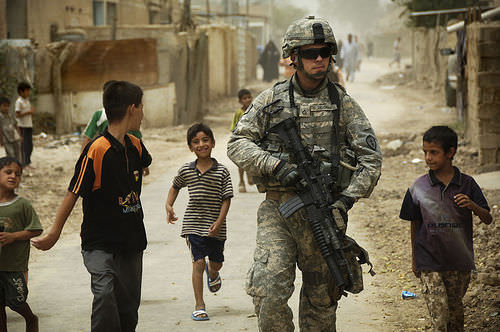
The president is in many ways the leader of the foreign policy domain. When the United States wishes to discuss important issues with other nations, the president (or a representative such as the secretary of state) typically does the talking.
What is Foreign Policy?
A country's foreign policy consists of self-interest strategies chosen by the state to safeguard its national interests and to achieve its own goals through relations with other countries. The approaches are strategically employed to interact with other countries.
In recent times, due to the deepening level of globalization and transnational activities, states also have to interact with non-state actors. The aforementioned interaction is evaluated and monitored in an attempt to maximize benefits of multilateral international cooperation. Since the national interests are paramount, foreign policies are designed by the government through high-level decision making processes. National interest accomplishments can occur as a result of peaceful cooperation with other nations or through exploitation.
Elements of Foreign Policy
Foreign policy is designed to protect the national interests of the state. Modern foreign policy has become quite complex. In the past, foreign policy may have concerned itself primarily with policies solely related to national interest--for example, military power or treaties. Currently, foreign policy encompasses trade, finance, human rights, environmental, and cultural issues. All of these issues, in some way, impact how countries interact with one another and how they pursue their national interests worldwide.
Who is in Charge of Foreign Policy?
Usually, creating foreign policy is designated to the head of government and the foreign minister (or equivalent). In some countries the legislature also has considerable oversight.
In the United States, foreign policy is made and carried out by the executive branch, particularly the president, with the national security adviser, the State Department, the Defense Department, the Department of Homeland Security, and the intelligence agencies. The National Security Act of 1947 and recent bureaucratic reorganization after 9/11 reshaped the structure of foreign policy making.
The U.S. Secretary of State is analogous to the foreign minister of other nations and is the official charged with state-to-state diplomacy, although the president has ultimate authority over foreign policy.
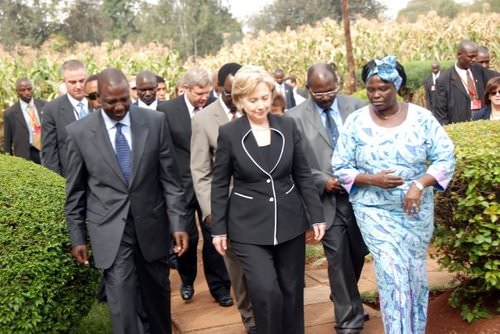
Congress is involved in foreign policy through its amending, oversight, and budgetary powers and through the constitutional power related to appointments, treaties, and war that it shares with the president. While Congress has sometimes worked to limit the president's autonomy in foreign policy, the use of executive orders and the ability to enter military engagements without formal declarations of war have ensured the president's continued primacy in international affairs. Forces that sometimes influence foreign and military policies from outside government are think tanks, interest groups, and public opinion.
U.S. Foreign Policy
The foreign policy of the United States is the way in which it interacts with foreign nations. Foreign policy sets standards of interaction for its organizations, corporations, and individual citizens. Two visions of foreign policy in the U.S. are isolationism and internationalism, which has been dominant since World War II. The main foreign policies during the Cold War were containment, deterrence, détente, arms control, and the use of military force like in Vietnam.
U.S. foreign policy is far-reaching because the United States is the global superpower and world leader. It operates in a world beset by famine, poverty, disease, and catastrophes both natural (tsunamis, earthquakes) and man-made (climate change, pollution of the seas and skies, and release of radioactive materials from nuclear plants). Parts of the world are plagued by genocide, regional and ethnic strife, and refugees. Terrorism, conflicts in Iraq and Afghanistan, the nuclear weapons programs of Iran and North Korea, the proliferation of weapons of mass destruction, the Arab-Israeli conflict, and instability and challenges to autocratic rulers in the Middle East are only the most obvious of the foreign policy issues that affect the United States. Others issues include economic upheavals, the rise of China to world economic and political power, relations with Russia, AIDS in Africa, dependence on oil from non-democratic states, the importation of illegal drugs, and the annual U.S. trade deficit of around $800 billion .
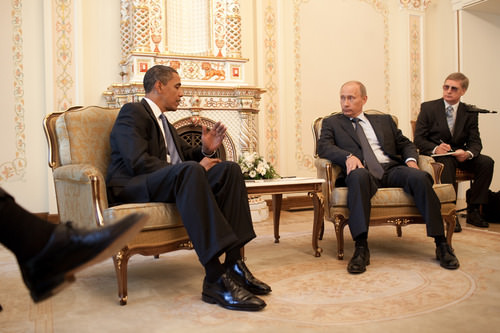
To prepare for these foreign policy issues, U.S. military expenditures are enormous. The annual defense budget is around 1.3 trillion. It has formal or informal agreements to defend 37 countries. It has more than 700 military installations abroad in approximately 130 countries . The United States is extraordinarily active, often militarily, in international affairs. Since 1989, it has intervened in Panama, Kuwait, Somalia, Bosnia, Haiti, Kosovo, Afghanistan, and Iraq.

National Security Policies
National security policies are policies related to the survival of the state. This security is guaranteed through the use of economic coercion, diplomacy, political power, and the projection of power. This concept developed primarily in the United States after World War II.
Initially focused on military might, national security now encompasses a broad range of concerns. In order to possess national security, a nation needs to possess economic security, energy security, and environmental security, in addition to a strong military. Security threats involve not only conventional foes, such as other nation-states, but also non-state actors, like violent non-state actors (al Queda, for example), narcotic cartels, multinational corporations and non-governmental organizations. Some authorities include natural disasters and other environmentally detrimental events in this category.
Policies and measures taken to ensure national security include:
- Using diplomacy to rally allies and isolate threats
- Marshalling economic power to facilitate or compel cooperation
- Maintaining effective armed forces
- Implementing civil defense and emergency preparedness measures (this includes anti-terrorism legislation)
- Ensuring the resilience of a critical national infrastructure
- Using intelligence services to defeat threats, and,
- Using counterintelligence services to protect the nation from internal threats.
National Security Policy History
The concept of national security became an official guiding principle of US foreign policy when the National Security Act of 1947 was signed on July 26, 1947, by President Harry S. Truman. Together with its 1949 amendment, this act instantiated important organizations dedicated to American national security, such as the precursor to the Department of Defense. It also subordinated all military branches to the new cabinet level position of the Secretary of Defense, established the National Security Council, and established the Central Intelligence Agency.

Current National Security Policy
At President Trump's Third State of the Union Address delivered on February 5, 2019, the President prioritized the following:
- Stop illegal immigration
- Overhaul immigration system
- Defend southern border against criminal activity (sexual assault, human and sex trafficking, drugs, gangs, murder) by building a wall.
- Rebuild the United States Military
- Increase in defense spending from NATO allies
- Develop a state-of-the-art Missile Defense System
- Withdrawal from the Intermediate-Range Nuclear Forces Treaty, or INF Treaty.
- Push for peace on the Korean Peninsula.
- Recognize the legitimate government of Venezuela
- Recognize the true capital of Israel
- Open the American Embassy in Jerusalem
- Destroy the remnants of ISIS
- Reduce troop presence in Afghanistan and focus on counter-terrorism
Military security was the earliest recognized form of national security. Military security implies the capability of a nation to defend itself and/or deter military aggression. Military security also implies the ability of a nation to enforce its policy choices through the use of military force .Elements of National Security
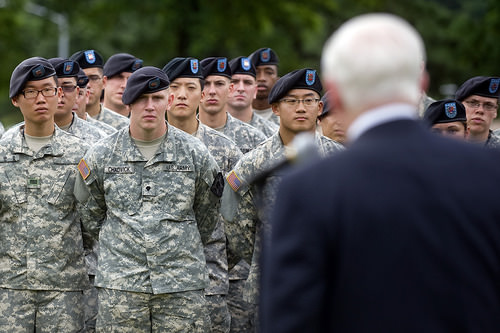
The political aspect of security is another important facet of national security. Political security concerns the stability of the social order, and refers to policies related to diplomacy, negotiation, and other interactions.
Economic security is also a part of national security. In today's complex system of international trade, characterized by multi-national agreements, mutual inter-dependence, and limited natural resources, economic security refers to whether or not a nation is free to develop its own economy in the manner desired. Economic security today is, arguably, as important a part of national security as military security.
Environmental security deals with environmental issues. While all environmental events are not considered significant enough to be categorized as threats, many transnational issues, both global and regional, stand to affect national security. These include global warming, deforestation, or conflicts over limited resources.
Energy security, as it relates to natural resources, is a final important component of national security. For a nation to be able to develop its industry and maintain economic competitiveness, it must have available and affordable natural resources.
Rights Versus Security
Measures adopted to maintain national security have led to an ongoing tension between the preservation of the state, and the rights and freedoms of individual citizens within that state. Although national security measures are imposed to protect society as a whole, many such measures restrict the rights and freedoms of individuals in society. Many are concerned that if national security policies are not subject to good governance, the rule of law, or strict checks and balances, that there is a risk that "national security policy" may simply serve as a pretext for suppressing unfavorable political and social views.

In the United States, the controversial USA PATRIOT Act, as well as other recent government actions, has brought some of these issues to public attention. These issues have raised two main questions. First, to what extent, for the sake of national security, should individual rights and freedoms be restricted? Second, can the restriction of civil rights for the sake of national security be justified?
Diplomacy and Foreign Relations
Diplomacy is the art and practice of conducting negotiations between representatives of groups or states. It usually refers to the conduct of international relations through the intercession of professional diplomats with regard to issues of peace-making, trade, war, economics, culture, environment, and human rights. International treaties are usually negotiated by diplomats prior to endorsement by national politicians .
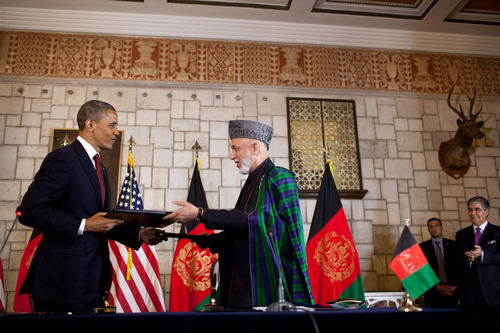
To some extent, all other tools of international relations can be considered the failure of diplomacy. Keeping in mind, the use of other tools are part of the communication and negotiation inherent within diplomacy. Sanctions, force, and adjusting trade regulations, while not typically considered part of diplomacy, are actually valuable tools in the interest of leverage and placement in negotiations.
Diplomatic Recognition
Diplomatic recognition is an important element of diplomacy because recognition often determines whether a nation is an independent state. Receiving recognition is usually difficult, even for countries which are fully sovereign.
Today there are a number of independent entities without widespread diplomatic recognition, most notably the Republic of China (ROC)/Taiwan on Taiwan Island. Since the 1970's, most nations have stopped officially recognizing the ROC's existence on Taiwan, at the insistence of the People's Republic of China (PRC). Currently, the United States maintains informal relations through de facto embassies, with names such as the American Institute in Taiwan. Similarly, Taiwan's de facto embassies abroad are known by names like the Taipei Economic and Cultural Representative Office. This was not always the case, with the U.S. maintaining official diplomatic ties with the ROC. The U.S. recognized it as the sole and legitimate government of "all of China" until 1979, when these relations were broken off as a condition for establishing official relations with The People’s Republic (“PR”) of China .
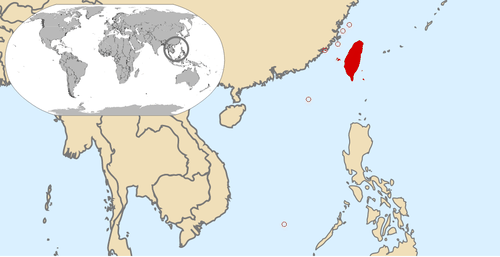
The Palestinian National Authority has its own diplomatic service. However, Palestinian representatives in most Western countries are not accorded diplomatic immunity. Their missions are referred to as Delegations General.
Other unrecognized regions that claim independence include Abkhazia, Transnistria, Somaliland, South Ossetia, Nagorno Karabakh, and the Turkish Republic of Northern Cyprus. Lacking the economic and political importance of Taiwan, these nations tend to be much more diplomatically isolated.
Informal Diplomacy
Informal diplomacy is also a key component of diplomacy. Sometimes called "track II diplomacy," the U.S. has used informal diplomacy for decades to communicate between powers. Most diplomats work to recruit figures in other nations who might be able to give informal access to a country's leadership. In some situations, like between the United States and China, a large amount of diplomacy is done through semi-formal channels using interlocutors such as academic members of think tanks. This occurs in situations where governments wish to express intentions or to suggest methods of resolving a diplomatic situation, but do not wish to express a formal position.
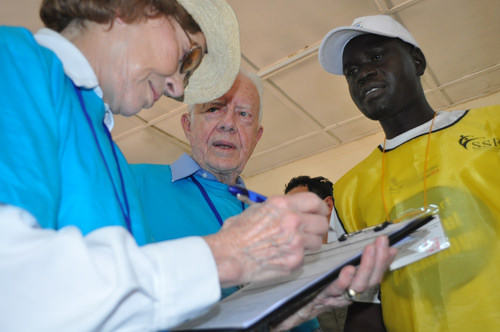
Diplomacy as Soft Power
The concept of power in international relations can be described as the degree of resources, capabilities, and influence in international affairs. It is often divided up into the concepts of hard power and soft power. Hard power relates primarily to coercive power, such as the use of force. Soft power commonly covers economics, diplomacy, and cultural influence. There is no clear dividing line between the two forms of power. However, diplomacy is usually regarded as being important in the creation of "soft" power, while military power is important for "hard" power.
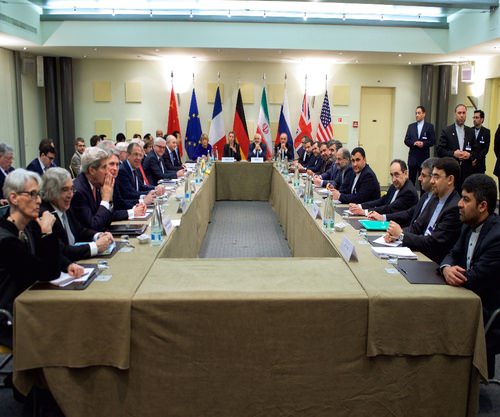
Humanitarian Policies
In its most general form, humanitarianism is an ethic of kindness, benevolence, and sympathy extended universally and impartially to all human beings. International humanitarian policies, then, are policies presumably enacted to reduce suffering of human beings around the world. International humanitarian policies can take a number of different forms. For example, human rights and human rights laws seek to protect essential rights and fight for justice if these rights are violated. International humanitarian interventions are military or non-military interventions into another country to halt widespread violence or war. Foreign aid seeks to provide countries with resources (economic or otherwise) that they can use to ease the suffering of their people.
Humanitarian Intervention
Humanitarian intervention is a state's use of "military force against another state when the chief publicly declared aim of that military action is ending human-rights violations being perpetrated by the state against which it is directed. "
The subject of humanitarian intervention has remained a compelling foreign policy issue, since it highlights the tension between the principle of state sovereignty – a defining pillar of the UN system and international law – and evolving international norms related to human rights and the use of force. Moreover, it has sparked debates over its legality, the ethics of using military force to respond to human rights violations, when it should occur, who should intervene, and whether it is effective.
Some argue that the United States uses humanitarian pretexts to pursue otherwise unacceptable goals. They argue that the United States has continued to act with its own interests in mind, with the only change being that humanitarianism has become a legitimizing ideology for projection of U.S. power. In particular, some argue that the 1999 NATO intervention in Kosovo was conducted largely to boost NATO's credibility.
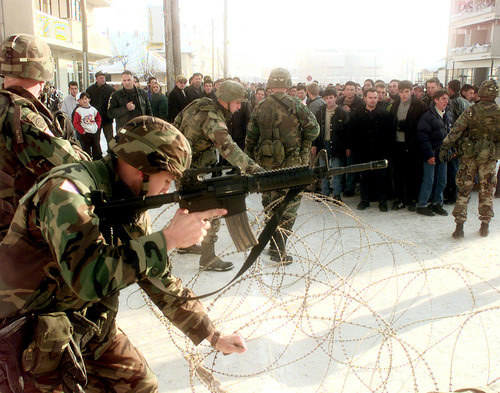
Types of Economic Foreign Aid
There are three main types of economic foreign aid: humanitarian aid, development aid, and food aid. Humanitarian aid or emergency aid is rapid assistance given to people in immediate distress to relieve suffering, during and after man-made emergencies (like wars) and natural disasters. Development aid is aid given by developed countries to support development in general. It is distinguished from humanitarian aid as being aimed at alleviating poverty in the long term, rather than alleviating suffering in the short term. Food aid can benefit people suffering from a shortage of food. It can be used to increase standard of living to the point that food aid is no longer required . Conversely, badly managed food aid can create problems by disrupting local markets, depressing crop prices, and discouraging food production.
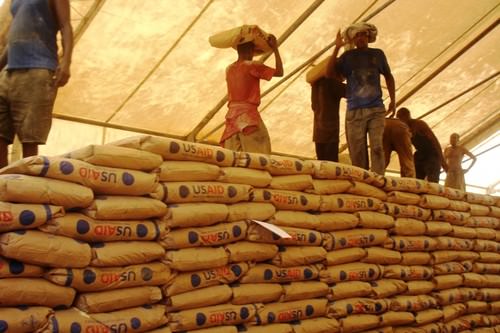
The U.S. and Foreign Aid
Foreign assistance is a core component of the State Department's international affairs budget and is considered an essential instrument of U.S. foreign policy. Foreign aid has been given to a variety of recipients, including developing countries, countries of strategic importance to the United States, and countries recovering from war. The government channels about half of its economic assistance through a specialized agency called the United States Agency for International Development (USAID) .
The 2010 United States federal budget spent 37.7 billion on economic aid (of which USAID received 14.1 billion) out of the 3.55 trillion budget. Aid from private sources within the United States in 2007 was probably somewhere in the 10 to $30 billion range. In absolute dollar terms, the United States is the largest international aid donor, but as a percent of gross national income, its contribution to economic aid is only 0.2%, proportionally much smaller than contributions of countries such as Sweden (1.04%) and the United Kingdom (0.52%).
The U.S. and Human Rights Policies
The United States' record on human rights is mixed. The United States has backed unpopular leaders (the Shah of Iran, 1941-1979, for example), mired itself in losing battles (consider the Vietnam War, 1950-1975), ignored ethnic cleansing (as was the case in Rwanda, 1994), and given foreign aid to corrupt regimes (as it did to Egypt, 1952-2011). Too often, the United States has had to support the lesser of two evils when it comes to relations with developing nations. And too often, the blowback from these awkward relationships has resulted in resentment from both United States citizens and the oppressed citizens of the developing nations (Guatemala, 1950's, and Nicaragua, 1912-1933). However, the United States remains the largest contributor of foreign aid, and is currently backing what some refer to as the awakening of the Arab world (Libya, 2011), supporting "the people" even though the outcome is not yet clear.
Sources of the United States' Economic Prosperity
In the two hundred and thirty years since the independence of the United States, the country has grown to be a huge, integrated, industrialized economy that makes up nearly a quarter of the world economy. The main policies that contributed to this economic prosperity were a large unified market, a supportive political-legal system, vast areas of highly productive farmlands, vast natural resources (especially timber, coal, iron, and oil) , and an entrepreneurial spirit and commitment to investing in material and human capital. The United States' economy has maintained high wages, attracting immigrants by the millions from all over the world. Technological and industrial factors have also played a major role in the United States' economic prosperity .
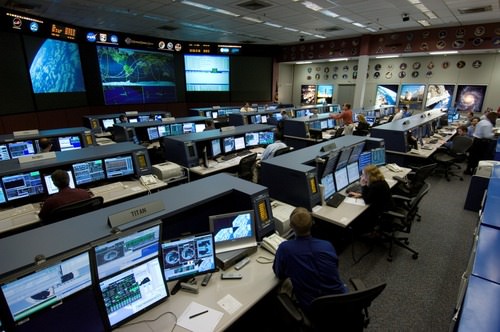
Economic Prosperity and Foreign Policy
The United States is highly influential in the world, primarily because the United States's foreign policy is backed by a $15 trillion economy, which is approximately a quarter of the global gross domestic product (GDP). Economic prosperity is a central component of any states' foreign policy. Without substantial economic means, a state cannot expect to have influence on the world stage. Similarly, economic prosperity is tied to the maintenance of a global military presence. Without a strong military, the pursuit of national interests becomes more difficult.
Continued Economic Prosperity?
In 2008, a perfect storm of economic disasters hit the United States and indeed the entire world. The most serious began with the collapse of housing bubbles in California and Florida, along with the collapse of housing prices and the construction industry. A series of the largest banks in the United States and Europe also collapsed; some went bankrupt, others were bailed out by the government. The United States government voted 700 billion in bailout money, committed trillions of dollars to shoring up the financial system, but the measures did not reverse the declines. Banks drastically tightened their lending policies, despite infusions of federal money. The stock market plunged 40%, wiping out tens of trillions of dollars in wealth; housing prices fell 20% nationwide wiping out trillions more. By late 2008, distress was spreading beyond the financial and housing sectors. President Barack Obama signed the American Recovery and Reinvestment Act of 2009 in February 2009; the bill provides 787 billion in stimulus through a combination of spending and tax cuts.
Due to the close relationship between economic prosperity and foreign policy, the recession has impacted all elements of the United States' foreign policy. Cuts to the military and defense spending have been threatened, and this economic crisis will undoubtedly take a toll on the United State's position as a global superpower. However, despite the economic recession, the sheer size of the United State's economy ensures that it will remain an important actor in the world economy .


Study/Discussion Questions
- Why must a nation develop and maintain foreign policy?
- Which executive department(s) is/are in charge of foreign policy?
- Who implements and administers foreign policy on behalf of the President?
- Why are U.S. military expenditures so high in comparison to most domestic expenditures?
- What are national security policies? What types of strategies/policies are included as a part of national security policy?
- When did national security policy become an official part of the United States’ foreign policy toolbox?
- What are some of the United States’ current national security policies?
- What are the elements of national security and how are they used?
- How does a nation maintain a balance between the rights and freedoms of individual citizens and the mandate of national security?
- What is diplomacy? How is it used as a strategy in implementing and administering foreign policy activities?
Sources:
Boundless. “Foreign Policy.” Boundless Political Science. Boundless, 14 Nov. 2014. Retrieved 14 May. 2015 from https://www.boundless.com/political-science/textbooks/boundless-political -science-textbook/foreign-policy-18/foreign-policy-108/foreign-policy-571-5486/

